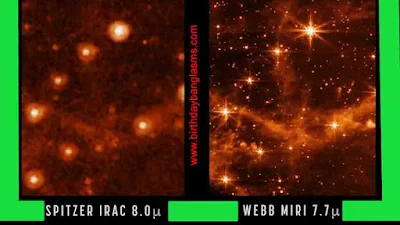The wonders of Nasa's james webb space telescope
 |
| james webb space telescope first image |
When it comes to exploring the universe, there's no stopping NASA. The agency has been at the forefront of space exploration for decades, and its latest venture is the James Webb Space Telescope (JWST).
Costing a whopping $10 billion, the JWST is the most expensive science project in history. But what makes it so special?
Simply put, the JWST is designed to do what its predecessors could not: see the universe's first stars and galaxies. Using infrared wavelengths, the telescope can peer back in time to a point just after the Big Bang.
This post will give you a brief overview of the Webb telescope and explain why it's such an important piece of equipment.
The Webb Telescope Will Use Infrared Wavelengths to See Objects That Are Otherwise Invisible to Us.
The Webb telescope will use infrared wavelengths to see objects that are otherwise invisible to us. By looking in the infrared spectrum, Webb will be able to pierce through the clouds of gas and dust that surround young stars and galaxies. This will allow us to see these objects in their infancy, when they are just starting to form.
Read more: What are the seven wonders in the world | where is the taj mahal india
Webb's infrared vision will also help us study the formation of planets and moons around young stars. This information is crucial in our quest to find out if life exists elsewhere in the universe.
The Webb Telescope Will Be Able to See the First Stars and Galaxies That Formed After the Big Bang.
The Webb telescope is a joint project between NASA and the European Space Agency (ESA). It's been in development for over two decades and is set to launch in 2021.
The Webb telescope will be able to see the first stars and galaxies that formed after the Big Bang. It's equipped with an infrared camera that can see through the fog of gas and dust that obscures our view of these objects. This will help us learn more about how the universe evolved over time.
The Webb Telescope Will Help Us Understand How the Universe Has Evolved Over Time.
The Webb telescope will help us understand how the universe has evolved over time. Using infrared wavelengths, it can see the first stars and galaxies that formed about 13 billion years ago after the Big Bang. This will give us a much better understanding of how the universe has changed over time, and how it will continue to change in the future.
The Webb Telescope Will Be Able to See Exoplanets, Which Are Planets That Orbit Stars Other Than Our Own.
NASA's James Webb Space Telescope is set to launch in 2021, and it's going to do some pretty amazing things! One of its primary goals is to study the first stars and galaxies that formed after the Big Bang. But that's not all—the Webb Telescope will also be able to see exoplanets, which are planets that orbit stars other than our own.
This is a huge accomplishment, as up until now we've only been able to see exoplanets by measuring their effect on their parent stars. By being able to actually see them, we can learn more about their composition and characteristics. This is an important step in our search for other Earth-like planets that could potentially support life.
The Webb Telescope Will Help Us Search for Life Beyond Our Solar System.
.jpg) |
| Nasa's james webb space telescope |
One of the main goals of the Webb telescope is to search for life beyond our Solar System. By using infrared wavelengths, it will be able to see the first stars and galaxies that formed about 13 billion years ago after the Big Bang. This will give us a much better understanding of how our galaxy and the universe formed, and could possibly provide us with clues about the existence of life elsewhere in the cosmos.
The Webb Telescope Is Expected to Launch in 2021.
The Webb telescope, using infrared wavelengths, will be able to see the first stars and galaxies that formed about 13 billion years ago after the Big Bang. It's a really exciting development, and scientists are expecting some amazing discoveries!
The telescope is expected to launch in 2021, and it will be positioned near the moon so that it can avoid Earth's atmosphere. This will allow it to study the universe in much greater detail than ever before.
Read more: What are the seven wonders in the world | where is the taj mahal india
Conclusion
The Webb telescope will help us see the universe's first stars and galaxies, which is a huge accomplishment! The telescope has been in development for over two decades and has had a few delays, but it's finally set to launch in 2021.
The Webb telescope is special because it's able to see in infrared wavelengths, which allows it to see through the dust that clouds our view of the early universe. This means we'll be able to learn more about how those first stars and galaxies formed and how they evolved over time.
We're so excited for the Webb telescope to launch and grateful for the amazing things it will teach us about our universe.

1 Comments
Wow nasa's james webb telescope is amazing
ReplyDelete